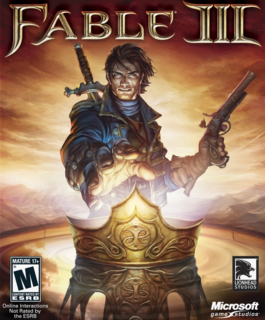Peter Molyneux called this title new, exciting, world changing like the first game. He really needs to stop lying.
The plot takes place fifty years after the events of Fable 2, the protagonist of that game seemingly becoming monarch during this period. Upon their passing, they left the kingdom of Albion to the players' brother, who upon the opening of the game has changed and become a Tyrant. It is the main characters role to escape from under his rule and lead a revolution against him. This only taking half of the game to accomplish, the second half consists of the player actually being the ruler of Albion through certain events, allowing the player to rule as they see fit, be it a heroic and beloved monarch, or a tyrant like the player's brother.
The game opens with a welcoming voice cast such as British idol's John Cleese, Stephen Fry, Zoë Wanamaker and many others. From the opening of the game the added improvement of the main character now having a voice is very welcome, with the previous instalments the protagonist was mute, thusly making them devoid of any kind of emotion, now however, there is a much more relatable personality to the hero, be they male or female, the player once again having the option to choose.
Despite the gorgeous graphics and the very familiar graphical style, the animations the game uses are very buggy and shoddy. On occasion the game will lag and the frame rate will slow, leading to the assumption the game was unfinished and essentially broken. Other instances of this include the clothing and weapons, and how well they appear together, meaning that some items simply do not go together in a mechanical sense. If the player wears a cloak for example, with a large hammer, when the weapon is sheathed on the players back, it will go through the cloak, as opposed to reacting with it accordingly.
With the large variety of new quests to enjoy, from chicken racing that the player can bet on and earn money to taking part in a 'game' that a group of mages are creating, there is a massive variety, much larger than the previous games. Other additions are the jobs, found in Fable 2, in which the player can go to a certain place of work and seek employment to earn money, such as Lute Hero – a Guitar Hero-like button prompt game, to Pie Making. These jobs can be fun and very enjoyable, however in essence; they are all re-skinned clones of each other, no job being very different to another.
The levelling system is a rather interesting addition, having the player unlocking new abilities and powers to purchase as they progress through the game, The Road to Rule has the player being able to see how far through the game they actually are by viewing this area.
Many of the faults of the previous games have not only not been improved, but in fact made worse, from the guide marker of the game being very buggy and not loading at times, to the absolute removal of a mini-map, the game seems to make navigation of the world harder. The addition of The Sanctuary however is rather welcome; the interactive pause menu is very interesting, allowing the player to change their clothes, weapons and even activate a fast travel world map simply by the push of a button. The idea however, does become rather tedious at times, due to the fact that this menu is not optional, forcing the player to have to use The Sanctuary, thusly removing a pause menu that does exactly what it is supposed to do, which is pause the game.
The combat is the same as in the first game, giving the player an option of three types of weapons, ranged, melee and magic, which can be used in conjunction with each other. The three types are mapped to three buttons on the joy pad, allowing for quick and simplistic combat, however despite the fluidity of the fighting system, it does become rather repetitive and tedious to use, due to certain enemies being vulnerable to certain types of weapons, which is essentially pointless due to how easily the player can switch between them, taking any challenge away from the combat. There is in fact an achievement which has the player go through the entire game without being defeated in combat, this being one of the easiest awards to obtain.
With the introduction of Fable in 2004 and the welcome release on Fable 2 in 2008, fans were sceptical of the third instalment due to how similar the first two games were. The Creative Director of Lionhead promised the title would be fantastic and a massive improvement on the first and second games. This statement could not have been more untrue. With Fable 3 having fluid combat, a simplistic level system and a mediocre story, players will find themselves in the same place of disillusion they found themselves in after the completion of the second title. The game is clearly incomplete with bugs and glitches being very easy to find and some of which are seemingly game breaking. In a word, Fable 3 is disappointing; however despite that, with a fifteen hour story, it is most certainly worth a rental.

